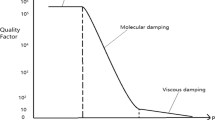Abstract
Rocking mass microgyroscope (ab. RMG) is an axial-symmetry vibratory microgyroscope with uniform vibratory type and equal nature frequency in ideal conditions; thus it has potential to be the microgyroscope with high sensitivity, and is the research hotspot now. One key factor which affects the sensitivity of RMG is its Q factors, which are related to various energy loss mechanisms in its vibrating micro-structure. Air damping, support loss, thermoelastic damping, base energy loss, and other energy loss mechanisms for RMG are systematically researched, relevant analytical models are solved, and the influences of its structural parameters on Q factors are also analyzed. Results indicate that: air damping is the dominant energy loss for RMG in the air, which means vacuum encapsulation technique must be adopted; support loss, thermoelastic damping and base energy loss are important energy loss mechanisms for RMG in vacuum packages, via synthetically analyzing all analytical models solved. Experimental investigations partially validate conclusions above.











Similar content being viewed by others
References
Abdolvand R, Johari H, Ho GK et al (2006) Quality factor in trench-refilled polysilicon beam resonators. J Microelectromech Syst 15(3):471–478
Abroad F, Khan A (1999) Thermoelastic plane waves in a rotating isotropic medium. J Acoust Soc Am 136:243–247
Acar C, Shkel A (2009) MEMS vibratory gyroscopes structural approaches to improve robustness. Springer, New York, pp 106–107
Alper SE, Azgin K, Akin T (2007) A high-performance silicon-on-insulator MEMS gyroscope operating at atmospheric pressure. Sens Actuators A 135(1):34–42
Ansari M, Esmailzadeh E, Jalili N (2009) Coupled vibration and parameter sensitivity analysis of rocking mass vibrating gyroscopes. J Sound Vib 327(6):564–583
Bae YS, Haywonh KJ, Yee KY et al (2002) High performance MEMS microgyroscope. In: SPIE, vol 4755
Bao MH (2005) Analysis and design principles of MEMS devices. Elsevier, Amsterdam, pp 60–62
Bao MH, Yang H, Yin H et al (2002) Energy transfer model for squeeze-film air damping in low vacuum. J Micromech Microeng 6:341–346
Bao MH, Sun YC, Zhou J et al (2006) Squeeze-film Air damping of a torsion mirror at a finite tilting angle. J Micromech Microeng 8:2330–2335
Biot MA (1956) Thermoelasticity and irreversible thermodynamics. J Appl Phys 27:240–253
Chadwick P (1960) Thermoelasticity: the dynamical theory. Prog Solid Mech 1:265–328
Christian R (1966) The theory of oscillating-vane vacuum gauges. J Vac 16:175–178
Grossman A, Erley W, Hannon JB et al (1996) Giant surface stress in heteroepitaxial films: invalidation of a classical rule in epitaxy. Phys Rev Lett 77:127–130
Hao ZL, Ayazi F (2005) Thermoelastic damping in flexural mode ring gyroscope. In: Proceedings of IMECE 2005: ASME international mechanical engineering congress and exposition, Orlando, vol 11, pp 1–9
Hao ZL, Zaman MF, Sharma A et al (2006) Energy loss mechanisms in a bulk micromachined tuning fork gyroscope. In: IEEE Sensors 2006, Daegu, Korea, vol 10, pp 1333–1336
Ibach H (1994) Adsorbate induced surface stress. J Vac Sci Technol A 12:2240–2245
Keymeulen D, Fink W, Ferguson MI et al (2004) Tuning of MEMS devices using evolutionary computation and open-loop frequency response. In: IEEEAC, vol 12, pp 1–8
Keymeulen D, Ferguson MI, Breuer L et al (2006) Tuning of MEMS gyroscope using evolutionary algorithm and “switched drive-angle” method. In: IEEEAC, vol 1, pp 1–8
Kotru S, Zhong J, Highsmith A et al (2008) Design and fabrication of a meso-scale gyroscope. In: Proceedings of the 2008 IEEE workshop on microelectronics and electron devices, pp 5–8
Kotru S, Zhong J, Highsmith A et al (2010) Feasibility study of a micromachined single-axis vibratory gyroscope using piezoelectric PNZT thin films for actuation and sensing. Smart Mater Struct 6:1–11
Lifshitz R, Roukes ML (2000) Thermoelastic damping in micro and nanomechanical systems. Phys Rev B 61(8):5600–5608
Nowick AS, Berry BS (1972) Anelastic relaxation in crystalline solids. Academic Press, New York
Pandey AK, Pratap R (2008) A semi-analytical model for squeeze-film damping including rarefaction in a MEMS torsion mirror with complex geometry. J Micromech Microeng 9:1–12
Sander D, Tian Z, Kirschner J (1997) The role of surface stress in reconstruction, epitaxial growth and stabilization of mesoscopic structures. Surf Sci Rep 29:193–263
Wang FY, Wang FB, Cai SF et al (2002) Higher mathematics. Higher Education Publishing Company, Beijing, pp 311–316 (in Chinese)
Wang X, Xiao DB, Zhou ZL et al (2011) Support loss and Q factor enhancement for a rocking mass microgyroscope. Sensors 11:9807–9819
Yasumura KY, Stowe TD, Chow EM et al (2000) Quality factors in micron and submicron thick cantilevers. J Microelectromech Syst 9:117–125
Zener C (1937) Internal friction in solids. Phys Rev 52:230–235
Zener C (1938) Internal friction in solids. Phys Rev 53:90–101
Zener C (1948) Elasticity and anelasticity of metals. The University of Chicago Press, Chicago
Acknowledgments
The authors would like to thank the Laboratory of Microsystem, National University of Defense Technology, China, for equipment access and technical support.
Author information
Authors and Affiliations
Corresponding author
Rights and permissions
About this article
Cite this article
Wang, X., Xu, X., Zhu, T. et al. Analytical analysis and experimental investigation of energy loss mechanisms in rocking mass microgyroscope. Microsyst Technol 23, 1–12 (2017). https://doi.org/10.1007/s00542-015-2713-2
Received:
Accepted:
Published:
Issue Date:
DOI: https://doi.org/10.1007/s00542-015-2713-2




